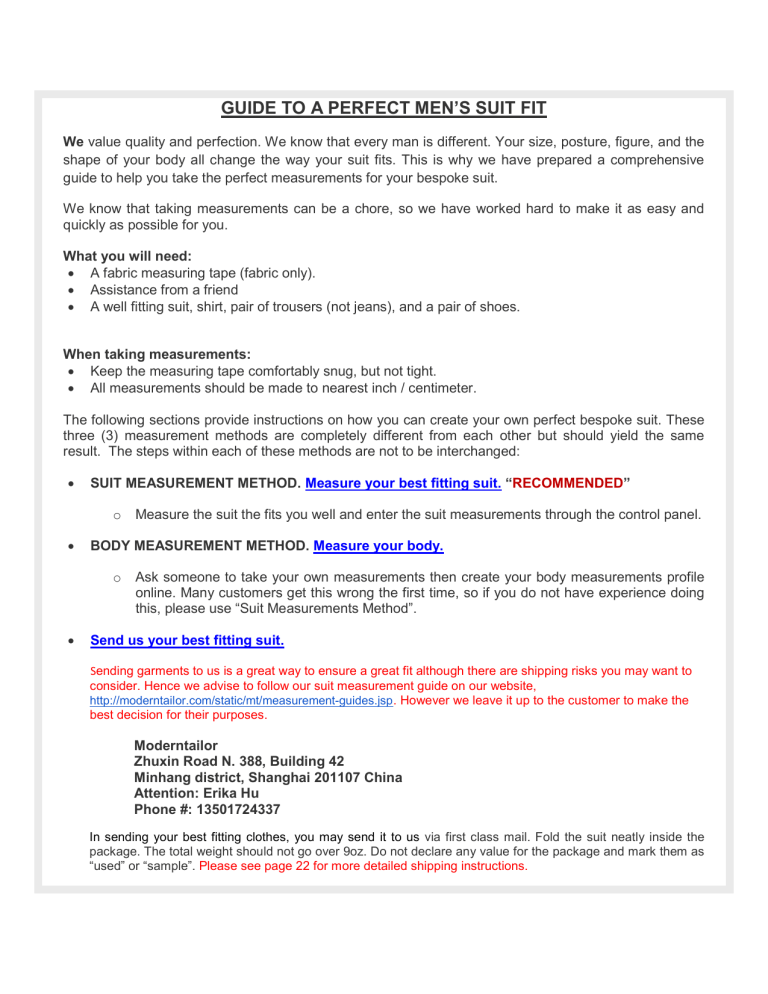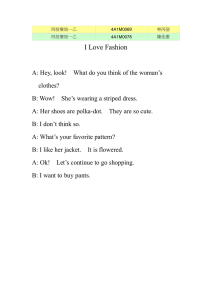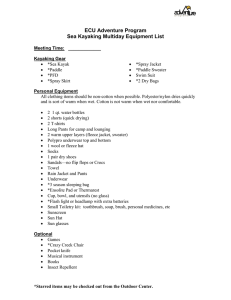guide to a perfect men`s suit fit

GUIDE TO A PERFECT MEN’S SUIT FIT
We value quality and perfection. We know that every man is different. Your size, posture, figure, and the shape of your body all change the way your suit fits. This is why we have prepared a comprehensive guide to help you take the perfect measurements for your bespoke suit.
We know that taking measurements can be a chore, so we have worked hard to make it as easy and quickly as possible for you.
What you will need:
A fabric measuring tape (fabric only).
Assistance from a friend
A well fitting suit, shirt, pair of trousers (not jeans), and a pair of shoes.
When taking measurements:
Keep the measuring tape comfortably snug, but not tight.
All measurements should be made to nearest inch / centimeter.
The following sections provide instructions on how you can create your own perfect bespoke suit. These three (3) measurement methods are completely different from each other but should yield the same result. The steps within each of these methods are not to be interchanged:
SUIT MEASUREMENT METHOD. Measure your best fitting suit.
“ RECOMMENDED ” o Measure the suit the fits you well and enter the suit measurements through the control panel.
BODY MEASUREMENT METHOD. Measure your body.
o Ask someone to take your own measurements then create your body measurements profile online. Many customers get this wrong the first time, so if you do not have experience doing this, please use “Suit Measurements Method”.
Send us your best fitting suit.
S ending garments to us is a great way to ensure a great fit although there are shipping risks you may want to consider. Hence we advise to follow our suit measurement guide on our website, http://moderntailor.com/static/mt/measurement-guides.jsp
. However we leave it up to the customer to make the best decision for their purposes.
Moderntailor
Zhuxin Road N. 388, Building 42
Minhang district, Shanghai 201107 China
Attention: Erika Hu
Phone #: 13501724337
In sending your best fitting clothes, you may send it to us via first class mail. Fold the suit neatly inside the package. The total weight should not go over 9oz. Do not declare any value for the package and mark them as
“used” or “sample”. Please see page 22 for more detailed shipping instructions.
Men’s Suit – Measure your best fitting suit
Please note that the suit should be laid flat on a table or smooth surface for proper measurement.
1. COLLAR
The collar measurement should be taken from the middle of the button hole to the center of the collar button when the collar is spread flat. You may take this measurement from a shirt that fits you well .
COLLAR
2. JACKET HALF CHEST
Button up the coat and lay it on flat surface. Measure from left edge to right edge just below the sleeves.
JACKET HALF CHEST
3. JACKET HALF WAIST
Button up the coat and lay it on flat surface. Measure from left edge to right edge at the waistline.
JACKET HALF WAIST
4. JACKET HALF
ARMHOLE
With the jacket laid flat, measure from top edge of shoulder to bottom edge of at the base of the jacket/pit.
JACKET HALF ARMHOLE
5. JACKET HALF GIRTH
Lay coat on flat surface and measure from center back seam across to top of middle
(2nd) button to coat edge.
JACKET HALF GIRTH
6. YOKE
Lay coat on flat surface and measure shoulders straight across from left shoulder seam to right shoulder seam.
YOKE
7. SHOULDER
Measure the distance between sleeve and collar along the shoulder seam.
SHOULDER
8. JACKET LENGTH
(LOWER)
Lay coat on flat surface and measure from outer shoulder seam connecting the sleeves to the bottom.
JACKET LENGTH (LOWER)
JACKET LENGTH (UPPER)
9. JACKET LENGTH
(UPPER)
Lay coat on flat surface and measure from shoulder seam connecting the neck to the bottom.
10. SLEEVE LENGTH
Lay coat on flat surface and measure with the sleeve at your side, from the shoulder's seam all along the arm until the end of the jacket sleeve.
SLEEVE LENGTH
11. SLEEVE WIDTH
Lay the sleeve of the coat on flat surface and measure from one side of the sleeve opening to the other side.
SLEEVE WIDTH
12. SLEEVE INSEAM
Lay coat on flat surface and measure inside seam of coat sleeve from armhole to edge of sleeve. (This is a secondary measurement as we use the
“ Sleeve Length ” as primary reference).
SLEEVE INSEAM
BOTTOM HEM WIDTH
13. BOTTOM HEM WIDTH
Button up the coat and lay it on flat surface. Measure from left edge to right edge at the base of the jacket.
14. HALF BACK WIDTH
Lay coat on flat surface and measure back of coat from where armhole meets the sleeve seam across back to center seam.
HALF BACK WIDTH
15. JACKET BACK
LENGTH
Lay coat on flat surface and measure felt under rear collar down the centre back length of coat to bottom.
JACKET BACK LENGTH
16. VEST LENGTH
Lay the vest on flat surface and measure from the top of the rear vest down the centre back length to bottom.
For your guidance, all finished products follow the international standards for allowances found on this link: http://moderntailor.com/pub/index.do?action=faq&id=2#23 . Allowances generally may depend on fabric weave, quality, measurement profile, and shirt design. Please visit our faqs for more information.
** Our tolerance of production (cutting commitment) is based on international standards.
Collar
Hip size
Sleeve length
: (+/-) 0.5 cm total circumference
Shoulder length/Yoke : (+/-) 0.6 cm Total length
Chest size
Waist size
: (+/-) 2.0cm Total circumference
: (+/-) 2.0 cm Total circumference
: (+/-) 2.0 cm Total circumference
: (+/-) 1.0 cm Total length
These allowances generally apply to all garment types: shirts, suits, jackets, pants for men and women.
Suit Pants – Measure your best fitting pants
Please note that the pants should be laid flat on a table or smooth surface for proper measurement .
1. HALF WAIST
1. Button up the pants.
2. Lay the garment out on a flat surface.
3. Measure from one side of the waist to the other.
HALF WAIST
2. HALF HIPS
1. Button up the pants.
2. Lay the garment out on a flat surface. Take care to pull any wrinkles and fullness from the back panels.
3. Measure the distance between the two hip points
“ C” & “ D” as shown by image on the left.
HALF HIPS
FRONT RISE
BACK RISE
1.
2.
3.
3. FRONT RISE
Button up the pants.
Lay the garment out on a flat surface. Take care to pull any wrinkles and fullness from the back panel.
Measure from the crotch seam - point “K” as shown in the left image (the point where the inseams meet) to the top of the waistband
(point “L” ).
4. BACK RISE
1. Button up the pants.
2. Lay the garment out on a flat surface. Take care to pull any wrinkles and fullness from the back panel.
3. Measure from the crotch seam- point “K” in the image on the left (the point where the inseams meet) to the top of the waistband (point “M” ).
INSEAM
HALF THIGH
5. INSEAM
1. Button up the pants.
2. Lay the garment out on a flat surface.
3. Measure the inseam distance from Crotch, where the front and back seams meet, point
“G” to the bottom of the leg, point “H” , at the length you wish to wear bearing in mind whether you wish to cover the boots or shoes.
6. HALF THIGH
1. Button up the pants.
2. Lay the garment out on a flat surface.
3. Measure at the crotch seam line – from point “E” as shown on the left image to the outside of the leg, point “F” , parallel to the waist band.
OUTSEAM
7. OUTSEAM/PANTS
LENGTH
1. Button up the pants.
2. Lay the garment out on a flat surface with outseams at both edges. Take care to pull any wrinkles and fullness from the back panel.
3. Measure the distance from the top of the waist band to the bottom of the hem.
1.
2.
3.
8. HALF KNEE
Button up the pants.
Lay the garment out on a flat surface. Take care to pull any wrinkles and fullness from the back panel.
The knee is positioned about
13” from the crotch seam halfway down. Measure the distance between points “N” and “O” as shown in the picture on the left.
KNEE
1.
2.
9. HALF HEM/LEG
OPENING
Lay the garment out on a flat surface.
Measure from one side of the leg opening to the other side - from points “P” to “Q” as shown in the picture on the left.
LEG OPENING
For your guidance, all finished products follow the international standards for allowances found on this link: http://moderntailor.com/pub/index.do?action=faq&id=2#23 . Allowances generally may depend on fabric weave, quality, measurement profile, and shirt design. Please visit our faqs for more information.
** Our tolerance of production (cutting commitment) is based on international standards.
Collar
Hip size
Sleeve length
: (+/-) 0.5 cm total circumference
Shoulder length/Yoke : (+/-) 0.6 cm Total length
Chest size
Waist size
: (+/-) 2.0cm Total circumference
: (+/-) 2.0 cm Total circumference
: (+/-) 2.0 cm Total circumference
: (+/-) 1.0 cm Total length
These allowances generally apply to all garment types: shirts, suits, jackets, pants for men and women.
Body Measurements
(Ask a friend for help or have your local tailor measure you based on our guide. Please note that our tailor will need to add allowances to your body measurements depending on your body profile.)
1. NECK
Measure around the lower part of your neck, placing a finger between the tape measure and the neck. You should not feel restricted by the tape for a comfortable fit, and should be able to put your index finger inside the tape.
2. CHEST
Measure around the fullest part of the chest.
The measuring tape is usually around the nipple level, under the armpits, and over your shoulder blades. Do not overinflate your chest but stand normally; you should be able to fit your index finger in between the tape and your chest.
3. STOMACH
Measure around the widest part of your abdomen, placing a finger between your body and the tape. Make sure the tape is at the same height at all times. The widest part of the abdomen usually coincides with the belly button. Do not hold your stomach in.
4. WAIST
Wearing trousers and a shirt put the measuring tape around your waist at the height were you would wear your pants and adjust to your designed snugness with room for a finger.
Make sure the tape is snug and does not ride over the waistband but you should be able to put your index finger inside the tape.
As a guide, this measurement will be about 2 inches above what you take off-the-rack as they like to flatter, but unfortunately we need real measurements.
5. HIPS
Wearing trousers, measure around the fullest part of your hips, placing a finger between your body and the tape. Make sure the tape is straight at all times.
Make sure your pockets are empty and the tape is not restrictive. As a guide, you should not make the tape too snug. You only just be able to feel the tape when measuring.
6. SHOULDER
Measure across the top of the shoulder from one edge to the other. Ensure you take the curved contour over the top of the shoulders as shown.
Wearing your best fitted shirt or suit measure up to the shoulder seams.
7. JACKET LENGTH
Measure from the highest part of your shoulder
(where shoulder and neck seams meet) all the way down to the desired length, usually around the thumb joint. When measuring, adopt an upright position with both arms on your sides.
A shorter, trendier length, looks good when coupled with jeans, but is an acquired taste in a suit.
8. SLEEVE LENGTH
Wearing a shirt that you like, measure with arm at your side, from the shoulder's seam all along the arm until you find the desired length.
Your measurement will be the length of your jacket sleeve.
We recommend that the sleeve should go to the base of your thumb (located at the wrist joint ).
9. BICEP
Measure around your upper arm at the widest point when flexed leaving one finger of space to take the measure.
10. WRIST
Measure around your wrist bone leaving one finger of space to take the measure.
11. VEST LENGTH
Measure from the lower point of the rear collar all the way down to the desired length, usually around the point where the vest covers your belt. When measuring, adopt an upright position with both arms on your sides.
12. CROTCH
Measure from the top middle of the back pants waist (see point A) all along the crotch seam through your legs until the top of front waist
(see point B)
Important: If you have any doubt, compare this measure with pants that fit you well.
13. THIGH WIDTH
Wearing trousers, empty your pockets then,
Start at the top of your inseam, measure around your thigh with room for a finger.
14. PANTS LENGTH
Measure from the top of pants waist all along the side pant seam until the bottom of your pants or roughly 1 inch from the ground.
15. INSEAM
Measure from the lowest part of your crotch area to the floor.
Make sure the tape is tight along the inside of your leg, that you are standing straight, and then measure.
No shoes please !
16. KNEE
Measure around your knee at its widest point.
You need only measure one knee.
17. HALF HEM
Measure the width you want for the bottom of your trousers.
For your guidance, all finished products follow the international standards for allowances found on this link: http://moderntailor.com/pub/index.do?action=faq&id=2#23 . Allowances generally may depend on fabric weave, quality, measurement profile, and shirt design. Please visit our faqs for more information.
** Our tolerance of production (cutting commitment) is based on international standards.
Collar
Hip size
Sleeve length
: (+/-) 0.5 cm total circumference
Shoulder length/Yoke : (+/-) 0.6 cm Total length
Chest size
Waist size
: (+/-) 2.0cm Total circumference
: (+/-) 2.0 cm Total circumference
: (+/-) 2.0 cm Total circumference
: (+/-) 1.0 cm Total length
These allowances generally apply to all garment types: shirts, suits, jackets, pants for men and women.
Send us your best fitting suit
Have a favorite suit that fits just right and you simply want a new suit that has the same wonderful fit? Mail it to us and we will do all the measuring. We will also keep a perfect record of the size and other details so you would not have to do this again. We will also take good care of your suit.
Please mail your suit to the address listed, include your notes on any changes to the size and style preference.
Your suit will be promptly returned to you along with your new suit.
Our Address:
Moderntailor
Zhuxin Road N. 388, Building 42
Minhang district, Shanghai 201107 China
Attention: Erika Hu
Phone #: 13501724337
*** S ending garments to us is a great way to ensure a great fit although there are shipping risks you may want to consider.
Hence we advise to follow our suit measurement guide on our website, http://moderntailor.com/static/mt/measurementguides.jsp
. However we leave it up to the customer to make the best decision for their purposes.***
1. Send the suit using First Class Mail (International Post) through your local post office. This is the cheapest way to send packages to us.
2. Include in the package the following details: order #, full name, registered email address, return/mailing address and instructions.
3. There is no need to purchase packaging or a large envelope for shipment. Fold the suit neatly and place it inside a regular envelope.
The total weight should not go over 9oz.
4. Mark the package as "used/sample clothing" so you can avoid paying additional/unnecessary customs taxes.
5. Email us the package reference number or customs declaration code provided by your post office (usually printed in the receipt).
Please remember to keep the receipt as Moderntailor will not be responsible for lost packages.

